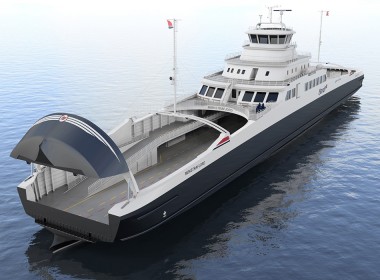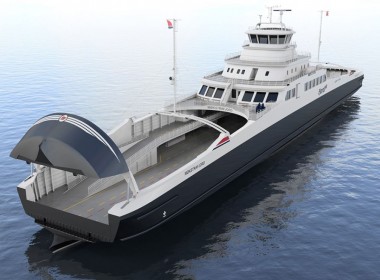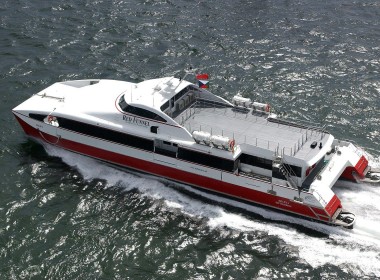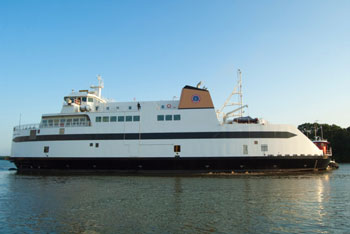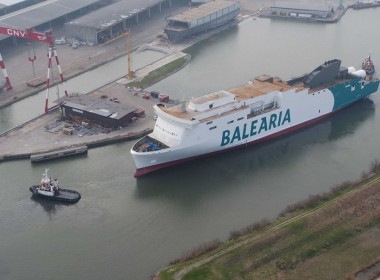OPINION | An impending ferry disaster on the Clyde: hundreds (of millions of pounds) lost, reputations ruined and shipyard bust. And fake windows painted on the bridge…

Usually ferry disasters in recent years have occurred in developing countries where a lack of maritime expertise, low standards, and poor enforcement of regulations can lead to tragic accidents and loss of life. See here for our September coverage of the Bangladesh ferry sinking at Panchagarh where over sixty people drowned, for example. Last month, there were fatal accidents as passenger craft also sank in Cambodia (here) and Nigeria (here).
Now, Scotland demonstrates that the same lack of maritime expertise, low standards and poor enforcement of regulations can lead to financial disaster as well, especially when aided and abetted by a desire to support local jobs and to support local businesses through a botched, even blatantly biased, public procurement process. Fortunately, no lives have been lost, but hundreds of millions of dollars of taxpayer’s cash have been wasted.
The problems stem from the Scottish Government’s decision in October 2015 to award local shipyard Ferguson Marine a contract to build two ferries for a supposedly fixed price of £97 million (which was then equivalent to US$149 million) for state-owned ferry company Caledonian Maritime Assets (CMAL). The Ferry Fiasco has attracted a lot of attention within Scotland, but very little outside.
For a change, our Nigerian readers can look at Scotland and marvel that such a rich country can be so badly governed. Meanwhile, other countries with marginal industries and powerful vested interests can watch and learn, especially at time when the Offshore Marine Service Association is urging the American government to tighten the country’s Jones Act restrictions further and insist that more ships are built in the USA for offshore wind projects.
“Jobs for the boys” often results in big bills for the taxpayer.
Ferguson Marine goes bust in 2014 but wins big in 2015
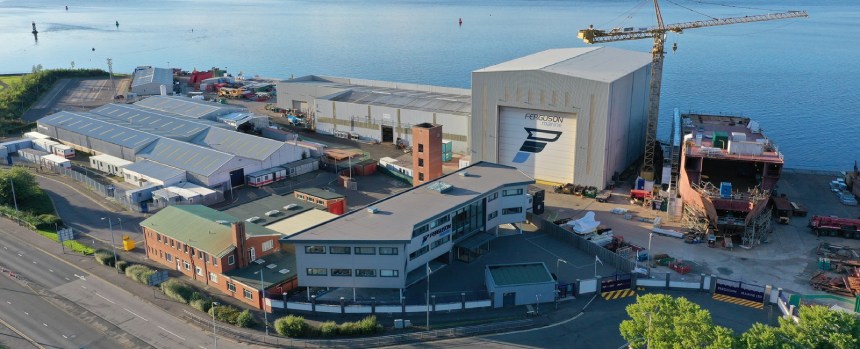
Ferguson was the last shipyard on the River Clyde, once the world’s most important shipbuilding centre. But, as everyone knows, faced with competition from Asian yards from the 1970s onwards, British shipbuilding collapsed amid strikes, bankruptcies, and a crisis in the wider ocean shipping industry (here). The Ferguson yard was nationalised in 1977 and then sold to various private owners, kept alive by a mix of orders for offshore vessels, research and fishery protection ships for various state agencies, and ferries – lots of ferries – in the twenty-first century.
By 2014, Ferguson was again in difficulties, however, and in August of that year, the company went into administration. The previous owners took away the ships’ models from the offices in a van on the night before the receivers moved in.
Ferguson was quickly purchased by the curiously named Clyde Blowers Capital, an industrial company specialising in hydraulics, pumps, and electrical machines. Clyde Bowers is owned by Jim McColl, the billionaire son of a butcher.
Clyde Blowers purchased the yard for £600,000 (then worth just under one million US dollars) in September 2014, a week before the Scottish people voted in a referendum on independence, which was narrowly rejected. The shipyard workers were re-employed with a five per cent pay rise in exchange for going without a tea break (here).
The revival of the yard was presented as a local boy made good rescuing local jobs in a sector that held great emotional resonance for many on the Clyde.
Monaco billionaire was close to Scottish government
Mr McColl conveniently sat on the Scottish First Minister’s council of economic advisers. Despite being resident in Monaco since 2001, McColl had been a staunch advocate for Scottish independence before the referendum, like the ruling Scottish National Party (SNP).
Mr McColl always claimed his move to Monte Carlo, “was driven by his love of sports cars and the Monaco Grand Prix, rather than any tax implications” (here). Yeah, right, sure. We believe you, Jim!
The writer W. Somerset Maugham described the principality as, “a sunny place for shady people,” a quote the travails of SBM’s corruption whistleblower suggest is still true today (here).
“No sweeteners.” Hmmm…
Mr McColl has repeatedly said there were “no sweeteners” from the Scottish government when he agreed to buy the yard. However, he did insist on a letter from the then First Minister Alex Salmond, promising a £12 million (then US$18 million) order for a small ferry (Catriona) for CMAL to enable him to commence shipbuilding at the yard again.
“Scottish shipbuilding can succeed in a competitive market”

When the big CMAL ferry contract was finally awarded in 2015, Scotland’s new First Minister, Nicola Sturgeon, gave some comments at the time of the contract award (here):
“This is an excellent result for Ferguson Marine… and I am delighted to name them as preferred tenderer for the contract to build two new ferries, the largest commercial vessels to be built on the Clyde since 2001,” said the First Minister. “Today’s announcement proves that Scottish shipbuilding can succeed in a competitive market, with the Ferguson team submitting the highest quality bid that offered best value for money.”
Rarely have words proved to be so completely wrong.
It’s all about the politics of (Scottish) nationalism
Cynics suggest that Ms Sturgeon rushed to make the announcement that Ferguson had won the ferry contract to overshadow a visit by Britain’s finance minister to Scotland that same day. On a visit to Faslane Naval Base, the Chancellor George Osborne said that a £500 million (then US$755 million) UK Government investment plan linked to the Trident nuclear submarines would safeguard almost 7,000 defence jobs in Scotland, and in Aberdeen he praised a multi-billion investment from Maersk Oil to develop the Culzean gas field.
The Culzean development was the gas discovery in the North Sea for a decade and the plan to proceed with its development would secure 6,000 jobs and create 400 new ones, the Chancellor claimed. Mr Osborne argued that these investments were only possible because Scotland was still in the United Kingdom.
Ms Sturgeon wanted to overshadow Osborne’s message with an important CMAL contract award to a local Scottish shipbuilder, stirring patriotic hearts and winning headlines.
Unfortunately, good intentions from politicians to create national champions don’t often mean good outcomes for taxpayers, as state businesses as diverse as Malaysia’s national car-maker Proton, Italy’s national airline Alitalia, and Australia’s several failed national shipping lines (here), demonstrate.
Spoiler alert: Sturgeon was wrong, Ferguson was hopeless
Seven years later, the Ferguson hulls are still under construction, the shipyard has gone bust and been nationalised by the Scottish Government, and the total cost of the ferries has risen to nearer £300 million (US$354 million at today’s rates), all of which will be paid by long-suffering Scottish taxpayers.
Additionally, the communities in the Western Isles served by CMAL’s ferry operating sister-company CalMac have suffered from ferry breakdowns and delays, as older vessels have continued in service due to the non-arrival of the Ferguson ships. CalMac has had to charter in vessels from the Isle of Man ferry service to plug gaps in its schedule. The Isle of Arran route, where the first Ferguson ferry was due to enter service in 2018, has faced more than 2,500 cancellations in the past five years, the BBC has found.
The fullest account of the fiasco is contained in a report into the saga from the Scottish Parliament’s Rural Economy and Connectivity Committee in 2020, which you can download here. Since the report was published, the cost overrun has ballooned by another US$100 million more than the committee believed two years ago.
The report is littered with gems on how incompetently the contract tendering process was, and how inept Ferguson was at building the ships. This is not surprising because they started the building without having a detailed design. The adage that you plan to fail if you fail to plan was obviously not something Mr McColl had considered.
By the time the two ships are delivered, today’s expected final bill of £300 million (US$354 million at today’s rates) may well be an under-estimate.
Sail Bonny Boat… over the sea to Skye! When?
The vessels were designed as 102-metre-long, roll-on, roll-off vehicle passenger ferries, with capacity to carry 127 cars or 16 lorries, or a combination of both, and up to 1,000 passengers. The ferries will be dual-fuel vessels able to operate on either liquefied natural gas (LNG) or marine gas oil (MGO).
The first ferry was due to work between the Scottish mainland and the scenic Isle of Arran, the second between the islands of Skye, Harris, and North Uist in the Hebrides. The ferries’ operator CalMac says the ships will be capable of operating at speeds of up to 16.5 knots and will be fitted with three bow thrusters to provide a high level of manoeuvrability in the adverse weather conditions encountered on the west coast of Scotland.
At the time the contract was signed, the two vessels, yard hulls 801 and 802, were due to be delivered to CalMac by mid-2018. The latest news from the Clyde is that the ferry Glen Sannox, hull 801, will be delivered sometime next year, and the yet-to-be-named hull 802 will enter service sometime in 2024.
Maybe.
The tender specs were rushed, then leaked?
In winning the work, Ferguson beat off stiff competition from Remontowa in Poland and from Cemre in Turkey. Both are very well-known yards with very strong track records in ferries. Indeed, Remontowa has previously built three ferries for service with CalMac and a whole flotilla of offshore vessels for Tidewater.
A BBC investigation (here) has now revealed that CMAL’s flawed tendering process meant that Ferguson could hardly have lost. CMAL went to the yards bidding only with broad specifications for a vessel, not with a confirmed design that all bidders had to price and build. The tender gave the yard 15 months to design a suitable ship, but they had to stick to the fixed price they had offered two years prior.
The reason for this lack of a preferred design was that the Scottish Government insisted that CMAL had just three weeks to draw up its Specification of Technical and Operational Requirements before the bid was issued.
The BBC found that Ferguson obtained a 424-page document from a design consultant setting out CMAL’s technical requirements while other bidders had to rely on the more limited 125-page specification. The consultant had worked with CMAL on the specifications and was then employed by Ferguson to assist with their bid. The BBC did not name this individual or their company.
A key section of Ferguson’s technical proposal was mostly cut-and-pasted from this longer document and it enabled Ferguson to score high marks in the technical evaluation, to such an extent that the high technical score offset the fact that Ferguson’s bid for the two ferries wasn’t even the cheapest.
The Scottish Government told the Scottish parliamentary inquiry in 2020 that they didn’t see a problem with the same company working for both their procurement team and one of the bidders.
Could it be because conflict of interest isn’t a thing in Scotland?
More and more irregularities
The BBC’s lessons learned hit list (here) is very comprehensive. The Scottish shipyard was allowed to significantly change its design halfway through the tender evaluation process by developing a variant it had mentioned but discounted in its original submission. This change also allowed it to reduce its price by nearly £10 million, the BBC found, giving it a higher weighting in the commercial evaluation than it had when the bid was first assessed. Effectively, Ferguson was given a second chance to improve its proposal when it was clear it was not competitive.
Ferguson also benefited from an in-person clarification meeting with the Scottish procurement agency, whereas the other bidders were only sent clarifications by email.
Unsurprisingly, CalMac and the Scottish Government refused to give interviews to the BBC to answer the criticism of the process.
No guarantees
Critically, Ferguson was allowed to go ahead with its bid despite being unable to provide evidence of a builder’s refund guarantee. The refund guarantee is the buyer’s protection if the yard goes bust or fails to deliver the vessel – it is a bank guarantee where a third-party bank pays back the funds the buyer has advanced to the shipyard if the vessel isn’t delivered or the yard fails. Typically, a bank will demand collateral for such a guarantee, and Ferguson was still short on cash in 2015.
CalMac had made the provision of the refund guarantee mandatory for all bidders. Yards like Cemre and Remontowa would be able to provide them.
A small yard that recently emerged from bankruptcy would struggle to find a bank willing to provide the financial safeguard required by the buyers, unless the parent company stepped in. Ferguson was owned by a billionaire, Jim McColl. But clearly, he wasn’t going to risk his own capital on the CalMac ferry project, and crucially, his mate the First Minister had let Ferguson build the sweetener that wasn’t a sweetener, the small ferry Catriona, without providing a refund guarantee.
A procurement law expert told the BBC that the unequal treatment of bidders in a state tender process is a breach of EU law and could result in potential legal action for damages from unsuccessful bidders.
“We are investigating the matter,” Remontowa’s spokesman was reported in the Scottish press (here) as saying. “Our legal team realises the tender might have been fraught with irregularities. Much depends on whether the irregularities made public are confirmed. At the moment, our lawyers are analysing the situation to consider possible formal steps, but no binding decisions have yet been taken.”
Scottish taxpayers might be on the hook for yet more liabilities.
Scottish taxpayers on the hook
So, in the end, who stepped up to provide the refund guarantee that would protect state-owned ferry company CalMac if Ferguson, owned by a Scottish billionaire, failed to deliver the ships or went bust?
Why, no less than the Scottish government! This is why the Scottish taxpayer has ended up paying four times what the lowest bid (believed to be Cemre) offered.
A shipyard that cannot provide a refund guarantee is a shipyard where you should not order.
Once the Scottish government stepped in to provide the guarantee, it was liable for everything if Ferguson failed. This included the sunk costs, the ongoing costs of the yard, and the remaining costs to complete the ill-fated ferries.
And guess what? Ferguson failed, big time.
The inevitable happens
The LNG-powered vessels were bigger and more complex than anything Ferguson had built before. The company had lost many of its senior managers in the restructuring at the time the business went into receivership in 2014. Whilst it boasted a long track record, the team that had executed the track record was long gone.
Worse, the yard insisted on starting to build the vessels immediately so it could meet milestone payments under the building contract, even though it didn’t have a finalised design.
The Potemkin Ship on the Clyde
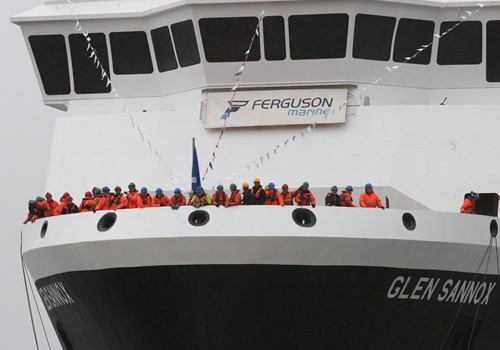
Because the technical specifications had been rushed together at short notice and no agreed confirmed design existed, Ferguson and CMAL immediately set about arguing over variation orders, changes to the design where the yard can charge its customer more for the extra costs incurred. Ferguson says that CMAL issued it 111 variation orders, which partly explains why costs for the two ships ballooned from the initial £97 million proposal.
The hunger to meet milestones led to scenes that verge on the fraudulent. Hull 801 was fitted with non-operational funnels, a fake bulbous bow, which was condemned by class and had to be removed, and best of all, fake windows were painted in black on the steel of the bridge, all so that the ship appeared to be more completed that it actually was (report here)!
Workers at the yard told the BBC that they were worried the Ferguson had over-promised and that the yard was not physically capable of doing what its new owner had promised CalMac.
“I’ve worked in there a long time,” yard employee Alex Logan said (here). “In my opinion it was impossible for us to build two ships that size side-by-side.”
From worse to worser
A series of disputes over designs and delays saw relations between CMAL and Ferguson completely break down, and the yard went bust – again – despite receiving a £45 million rescue loan from the Scottish government. That was written off in the restructuring.
Ferguson went into administration again and was nationalised in late 2019. Jim McColl lost the million dollars he had put in, but, again, provided no parent company guarantee against the rescue loan. The Scottish taxpayer has currently spent over two hundred times the amount of capital for which he bought the yard in 2015. A Freedom of Information request revealed that Ferguson has just 640 workers in total, including cleaners, security, subcontractors, and core staff.
A restructuring specialist was appointed by the government to turn the company around and charged over US$3,000 per day for his services for 18 months before he was fired. We suspect that restructuring guru Nicky Tan of nTan in Singapore would approve, but the Scottish taxpayers most certainly did not. His replacement has run some yacht building companies.
No progress on LNG, either, from sad to sadder
The two Calmac ferries were supposed to herald a new dawn of cleaner shipping in Scotland with their LNG fuel option. Unfortunately, to date, the state-owned sister company that operates the ports that the CalMac ferries serve has done nothing to build an LNG bunkering infrastructure. So CalMac now says that when Glen Sannox is finally delivered, the vessel will only run on low-sulphur diesel.
What a wasted opportunity, and what a massive waste of capital to build a dual-fuel vessel that cannot receive LNG because no infrastructure has been built seven years after the dual-fuel concept was locked into the newbuild designs!
Conclusions: no accountability
The Scottish National Party continues to dominate the Scottish political scene and holds control of the Scottish parliament.
This means that there are no effective means by which to hold Nicola Sturgeon and her ministers responsible for the monumental mess of the Ferguson Ferry Fiasco. The British government in London is quite happy to watch her flounder and waste her country’s money. There are hints of possible malfeasance at various points in the process, but nothing that might trigger a criminal investigation yet – and the police in the UK have proven toothless at challenging even flagrant lawbreaking by senior politicians, as Boris Johnson’s parties in Covid lockdown in Number Ten Downing Street demonstrated.
South Africans might have a sense of deja vu when they see state money being squandered in Scotland and nobody doing anything about it. Long-term control of a country by a single political party is dangerous, as it leads to bad decisions being unpunished and the government having a sense of entitlement that it can do whatever it wants.
Mackay’s texts doomed him
Derek Mackay, the Minister for Transport at the time of the contract award, did resign from the Scottish government in 2020, but only because he had been caught sending “inappropriate” social media messages to a teenage boy, whom he described as “cute” and offered to meet, just as all friendly parliamentarians do with young people all the time.
Mr Mackay has maintained solid loyalty to Ms Sturgeon in the various investigations on the Ferguson matter. Everyone in the SNP is sorry that the contract is a shambles, but nobody takes the blame or takes responsibility.
Checks and balances
The wider conclusion is that small countries, especially, need strong checks and balances. By definition, the elite pool is small in a country like Scotland, with a population of less than six million. This means that senior executives and politicians have a habit of rotating from one job to another, even if they did badly. It means local heroes like Jim McColl are given trust and access to the senior levels of government, a privilege that perhaps they don’t deserve.
Everyone knows everyone at the highest level and Group Think can be a problem – look at Western Australia’s incestuous elite that revolves from the oil company offices on St George’s Terrace into the state government on a routine basis.
National pride and local content are priorities for every country from Australia to Brazil and through to Nigeria and Saudi Arabia. But local content should not mean blindly choosing local companies that are not capable of performing, nor of tolerating poor performance.
Saving Ferguson’s workforce is money that could have been spent on nurses, teachers, or the police. Countries have to make trade-offs and to be open to best practices from abroad, whether in the choice of shipyard or even the concept selected.
CMAL’s entire procurement strategy for the Ferguson ferries was utterly flawed. Perhaps it should have considered catamarans (here), as Scottish-born, Australian ship designer Stuart Ballantyne has advocated.
Alarmingly, when challenged by Mr Ballantyne, the Scottish government told him that it would make investments in new vessels and port improvements over the next five years worth £580 million (then US$783 million). Unfortunately, the lesson of the Ferguson scandal is that without good management, solid planning and truly competitive processes, good money can be thrown after bad, over and over.
It’s not too late to change. Scottish taxpayers deserve better.
Background reading
The Scottish ferry scandal has its own Wikipedia page here. It is well written, fully sourced, and more detailed than our own account above. Jim McColl, Monaco resident and the former owner of Ferguson Marine, has his Wikipedia page here. Ferguson Marine’s wiki page with a full listing of the company’s 21st century builds is here.
The Great Ferries Scandal was broadcast on BBC One Scotland on Tuesday, September 27 – it is available to those in the UK with iPlayer here. This is investigative journalism at its best. Kudos to Mark Daly and his team.
Our founder Dr Neil Baird’s 2018 thesis on Fatal Ferry Accidents and How to Prevent Them can be downloaded from the Interferry website here.
In the above analysis, the Scottish state-owned ferry procurement body Caledonian Maritime Assets (CMAL) and ferry operator CalMac are easily confused. CMAL tendered for the ferries, but CalMac will operate them. Legally, the two entities are separate, but both are wholly-owned by the Scottish government. The CalMac website explains the history here.


